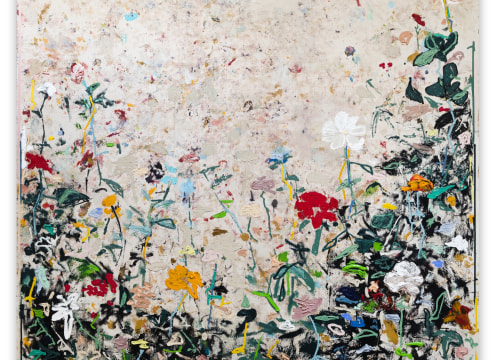
Eric Firestone Gallery is pleased to announce I Wish You Bluebirds, its debut solo exhibition of recent paintings by Huê Thi Hoffmaster (b. Lancaster, PA, 1982). The gallery has represented Hoffmaster since 2024.
Huê Thi Hoffmaster’s paintings reflect his mixed-race, multicultural Vietnamese-American identity. They are made in the studio and are abstracted, calligraphic depictions of flowering branches and thickets, growing amidst atmospheric grounds. These grounds alternate between raw canvas with inky wash underlayers, or lightly painted grounds. The artist has also used studio dropcloths, dotted with paint, as his supports, creating a visual parallel between the abundance of nature and a regenerative artistic practice.
The exhibition title, I Wish You Bluebirds, is a lyric from the song I Wish You Love. Listening to the version recorded by Joe Bataan evokes, for Hoffmaster, thought about family and ancestors he never knew, and the unlikely circumstances that led to his being. Hoffmaster’s mother is a Vietnamese-born woman whose formative years were spent in war. She met his father, an American soldier, during that same war. Hoffmaster grew up in a blue collar area of Pennsylvania, where neighbors were Vietnamese refugees and most members of the community were connected to the military. As a child, he keenly felt the recognition of racial difference between himself and each of his parents. In 2020, Hoffmaster changed his Western given name to Huê Thi, his mother’s name. The artist has described that this change catalyzed a period of fruition and opening-up, not unlike the blossoming and growth he metaphorically cultivates in his paintings.
Hoffmaster has allowed the duality of Eastern and Western traditions to dance together in his recent paintings without resolution, giving his work a powerful charge. Hoffmaster attended the Pennsylvania Academy of the Fine Arts, where he studied with Jan Baltzell and Bruce Samuelson. At PAFA, he forged his vision against the backdrop of the school’s lineage of Western academic drawing, painting, and sculpture. Hoffmaster instead connected with the Philadelphia Museum of Art gallery dedicated to Cy Twombly’s heroic, modernist ten-painting cycle, 50 Days at Iliam. In addition, he explored his Asian heritage by studying Chinese Ming Dynasty painters of the Wu School: Lü Ji and Xu Wei; Gao Fenghan, one of the Eight Eccentrics of Yangzhou in the early Qing Dynasty; as well as Japanese art of the 16th and 17th centuries. Lu Ji’s paintings of blossoms have the open negative space that Hoffmaster cultivates in his work. Xu Wei and Gao Fenghan were both poet-painters whose expression emerges from their loose and direct ink brushwork.
From his home in Weston, Connecticut, Hoffmaster spends time observing woods and thickets. However, his paintings are approached in the studio as abstractions and memories. They are not realist or observational paintings, but abstracted painterly works, in which blossoms dissolve into pure color areas and shapes. The supports that are studio remnants emphasize that these are paintings made in the studio, not outdoors from life. When looking at the work in person, it is clear that the paintings are, above all, explorations of paint itself, and expressionist compositions.
Hoffmaster views the abstracted shapes of his flowers and branches as symbolic representations of human interactions and connection. We can see his personal study of the Tao reflected in this approach to painting; Taoism is centered around the principle of oneness and human unity with nature. The artist locates within each blossom an individual personality and presence which reflects day-to-day psychological battles, conversations, and relationships with people around him. Just as flowers inherently represent impermanence, Hoffmaster demonstrates, in his painting style, an attitude of non-attachment to rendering or image. Instead, his paintings communicate a faith in our power to absorb change and manifest growth.



